Input interpretation

CuSO_4 copper(II) sulfate + BaO barium oxide ⟶ CuO cupric oxide + BaSO_4 barium sulfate
Balanced equation
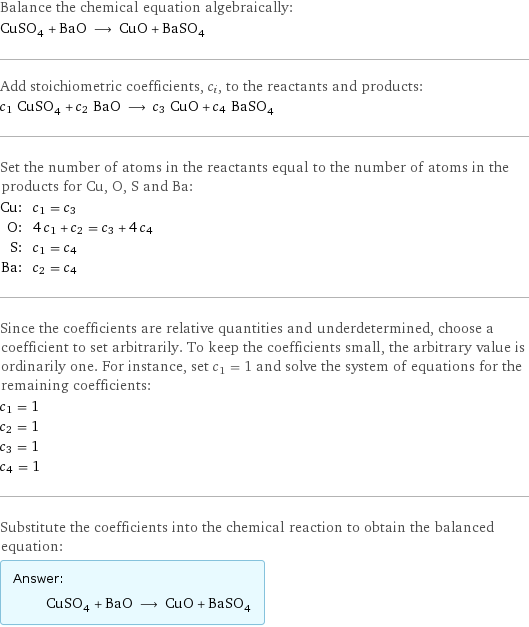
Balance the chemical equation algebraically: CuSO_4 + BaO ⟶ CuO + BaSO_4 Add stoichiometric coefficients, c_i, to the reactants and products: c_1 CuSO_4 + c_2 BaO ⟶ c_3 CuO + c_4 BaSO_4 Set the number of atoms in the reactants equal to the number of atoms in the products for Cu, O, S and Ba: Cu: | c_1 = c_3 O: | 4 c_1 + c_2 = c_3 + 4 c_4 S: | c_1 = c_4 Ba: | c_2 = c_4 Since the coefficients are relative quantities and underdetermined, choose a coefficient to set arbitrarily. To keep the coefficients small, the arbitrary value is ordinarily one. For instance, set c_1 = 1 and solve the system of equations for the remaining coefficients: c_1 = 1 c_2 = 1 c_3 = 1 c_4 = 1 Substitute the coefficients into the chemical reaction to obtain the balanced equation: Answer: | | CuSO_4 + BaO ⟶ CuO + BaSO_4
Structures

+ ⟶ +
Names

copper(II) sulfate + barium oxide ⟶ cupric oxide + barium sulfate
Reaction thermodynamics
Enthalpy
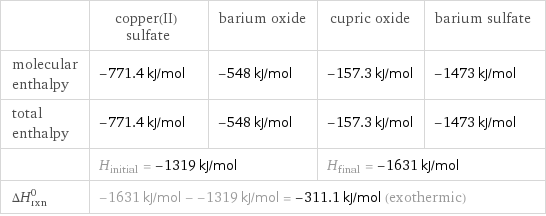
| copper(II) sulfate | barium oxide | cupric oxide | barium sulfate molecular enthalpy | -771.4 kJ/mol | -548 kJ/mol | -157.3 kJ/mol | -1473 kJ/mol total enthalpy | -771.4 kJ/mol | -548 kJ/mol | -157.3 kJ/mol | -1473 kJ/mol | H_initial = -1319 kJ/mol | | H_final = -1631 kJ/mol | ΔH_rxn^0 | -1631 kJ/mol - -1319 kJ/mol = -311.1 kJ/mol (exothermic) | | |
Gibbs free energy
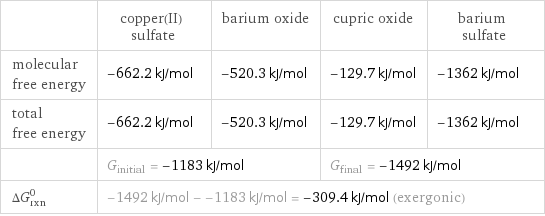
| copper(II) sulfate | barium oxide | cupric oxide | barium sulfate molecular free energy | -662.2 kJ/mol | -520.3 kJ/mol | -129.7 kJ/mol | -1362 kJ/mol total free energy | -662.2 kJ/mol | -520.3 kJ/mol | -129.7 kJ/mol | -1362 kJ/mol | G_initial = -1183 kJ/mol | | G_final = -1492 kJ/mol | ΔG_rxn^0 | -1492 kJ/mol - -1183 kJ/mol = -309.4 kJ/mol (exergonic) | | |
Equilibrium constant
![Construct the equilibrium constant, K, expression for: CuSO_4 + BaO ⟶ CuO + BaSO_4 Plan: • Balance the chemical equation. • Determine the stoichiometric numbers. • Assemble the activity expression for each chemical species. • Use the activity expressions to build the equilibrium constant expression. Write the balanced chemical equation: CuSO_4 + BaO ⟶ CuO + BaSO_4 Assign stoichiometric numbers, ν_i, using the stoichiometric coefficients, c_i, from the balanced chemical equation in the following manner: ν_i = -c_i for reactants and ν_i = c_i for products: chemical species | c_i | ν_i CuSO_4 | 1 | -1 BaO | 1 | -1 CuO | 1 | 1 BaSO_4 | 1 | 1 Assemble the activity expressions accounting for the state of matter and ν_i: chemical species | c_i | ν_i | activity expression CuSO_4 | 1 | -1 | ([CuSO4])^(-1) BaO | 1 | -1 | ([BaO])^(-1) CuO | 1 | 1 | [CuO] BaSO_4 | 1 | 1 | [BaSO4] The equilibrium constant symbol in the concentration basis is: K_c Mulitply the activity expressions to arrive at the K_c expression: Answer: | | K_c = ([CuSO4])^(-1) ([BaO])^(-1) [CuO] [BaSO4] = ([CuO] [BaSO4])/([CuSO4] [BaO])](../image_source/9ee95fbefe7dc234f8e3ea4de18902eb.png)
Construct the equilibrium constant, K, expression for: CuSO_4 + BaO ⟶ CuO + BaSO_4 Plan: • Balance the chemical equation. • Determine the stoichiometric numbers. • Assemble the activity expression for each chemical species. • Use the activity expressions to build the equilibrium constant expression. Write the balanced chemical equation: CuSO_4 + BaO ⟶ CuO + BaSO_4 Assign stoichiometric numbers, ν_i, using the stoichiometric coefficients, c_i, from the balanced chemical equation in the following manner: ν_i = -c_i for reactants and ν_i = c_i for products: chemical species | c_i | ν_i CuSO_4 | 1 | -1 BaO | 1 | -1 CuO | 1 | 1 BaSO_4 | 1 | 1 Assemble the activity expressions accounting for the state of matter and ν_i: chemical species | c_i | ν_i | activity expression CuSO_4 | 1 | -1 | ([CuSO4])^(-1) BaO | 1 | -1 | ([BaO])^(-1) CuO | 1 | 1 | [CuO] BaSO_4 | 1 | 1 | [BaSO4] The equilibrium constant symbol in the concentration basis is: K_c Mulitply the activity expressions to arrive at the K_c expression: Answer: | | K_c = ([CuSO4])^(-1) ([BaO])^(-1) [CuO] [BaSO4] = ([CuO] [BaSO4])/([CuSO4] [BaO])
Rate of reaction
![Construct the rate of reaction expression for: CuSO_4 + BaO ⟶ CuO + BaSO_4 Plan: • Balance the chemical equation. • Determine the stoichiometric numbers. • Assemble the rate term for each chemical species. • Write the rate of reaction expression. Write the balanced chemical equation: CuSO_4 + BaO ⟶ CuO + BaSO_4 Assign stoichiometric numbers, ν_i, using the stoichiometric coefficients, c_i, from the balanced chemical equation in the following manner: ν_i = -c_i for reactants and ν_i = c_i for products: chemical species | c_i | ν_i CuSO_4 | 1 | -1 BaO | 1 | -1 CuO | 1 | 1 BaSO_4 | 1 | 1 The rate term for each chemical species, B_i, is 1/ν_i(Δ[B_i])/(Δt) where [B_i] is the amount concentration and t is time: chemical species | c_i | ν_i | rate term CuSO_4 | 1 | -1 | -(Δ[CuSO4])/(Δt) BaO | 1 | -1 | -(Δ[BaO])/(Δt) CuO | 1 | 1 | (Δ[CuO])/(Δt) BaSO_4 | 1 | 1 | (Δ[BaSO4])/(Δt) (for infinitesimal rate of change, replace Δ with d) Set the rate terms equal to each other to arrive at the rate expression: Answer: | | rate = -(Δ[CuSO4])/(Δt) = -(Δ[BaO])/(Δt) = (Δ[CuO])/(Δt) = (Δ[BaSO4])/(Δt) (assuming constant volume and no accumulation of intermediates or side products)](../image_source/e52bd4363f49642a7a1a4145e07998ee.png)
Construct the rate of reaction expression for: CuSO_4 + BaO ⟶ CuO + BaSO_4 Plan: • Balance the chemical equation. • Determine the stoichiometric numbers. • Assemble the rate term for each chemical species. • Write the rate of reaction expression. Write the balanced chemical equation: CuSO_4 + BaO ⟶ CuO + BaSO_4 Assign stoichiometric numbers, ν_i, using the stoichiometric coefficients, c_i, from the balanced chemical equation in the following manner: ν_i = -c_i for reactants and ν_i = c_i for products: chemical species | c_i | ν_i CuSO_4 | 1 | -1 BaO | 1 | -1 CuO | 1 | 1 BaSO_4 | 1 | 1 The rate term for each chemical species, B_i, is 1/ν_i(Δ[B_i])/(Δt) where [B_i] is the amount concentration and t is time: chemical species | c_i | ν_i | rate term CuSO_4 | 1 | -1 | -(Δ[CuSO4])/(Δt) BaO | 1 | -1 | -(Δ[BaO])/(Δt) CuO | 1 | 1 | (Δ[CuO])/(Δt) BaSO_4 | 1 | 1 | (Δ[BaSO4])/(Δt) (for infinitesimal rate of change, replace Δ with d) Set the rate terms equal to each other to arrive at the rate expression: Answer: | | rate = -(Δ[CuSO4])/(Δt) = -(Δ[BaO])/(Δt) = (Δ[CuO])/(Δt) = (Δ[BaSO4])/(Δt) (assuming constant volume and no accumulation of intermediates or side products)
Chemical names and formulas
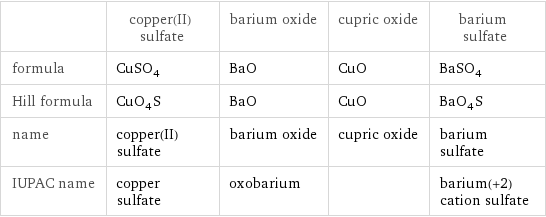
| copper(II) sulfate | barium oxide | cupric oxide | barium sulfate formula | CuSO_4 | BaO | CuO | BaSO_4 Hill formula | CuO_4S | BaO | CuO | BaO_4S name | copper(II) sulfate | barium oxide | cupric oxide | barium sulfate IUPAC name | copper sulfate | oxobarium | | barium(+2) cation sulfate
Substance properties
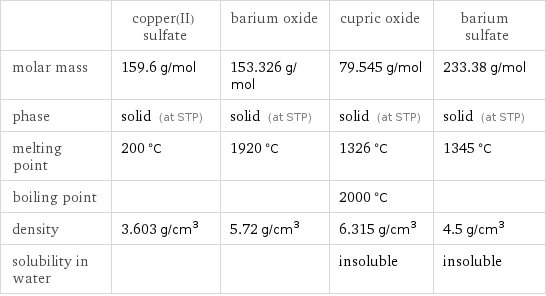
| copper(II) sulfate | barium oxide | cupric oxide | barium sulfate molar mass | 159.6 g/mol | 153.326 g/mol | 79.545 g/mol | 233.38 g/mol phase | solid (at STP) | solid (at STP) | solid (at STP) | solid (at STP) melting point | 200 °C | 1920 °C | 1326 °C | 1345 °C boiling point | | | 2000 °C | density | 3.603 g/cm^3 | 5.72 g/cm^3 | 6.315 g/cm^3 | 4.5 g/cm^3 solubility in water | | | insoluble | insoluble
Units
